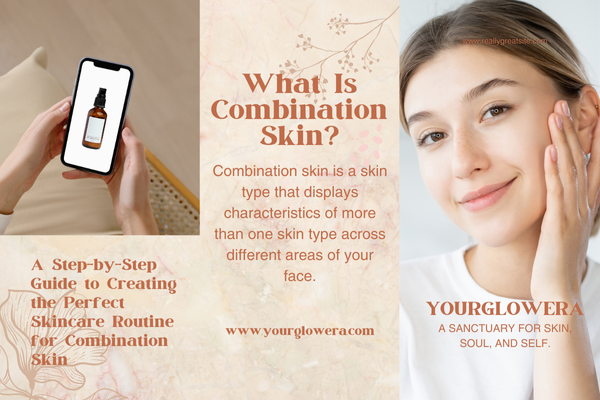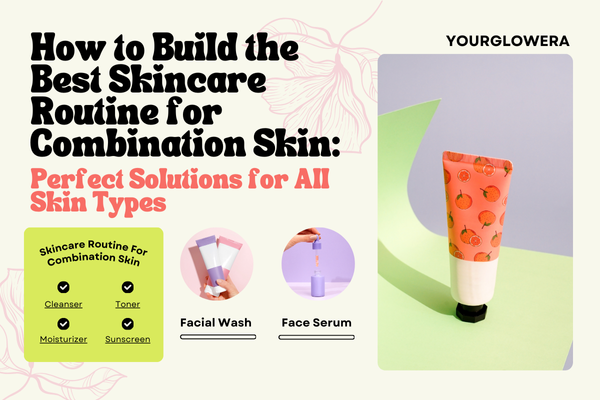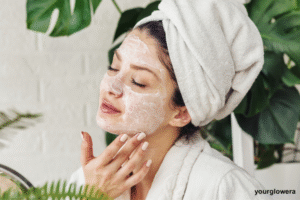When it comes to skincare, finding the best skincare routine for combination skin can feel like a balancing act. Combination skin can be challenging because it features two different skin types on the same face—usually an oily T-zone (forehead, nose, and chin) paired with dry or normal cheeks.
If you have combination skin, you need a skincare routine that addresses both the oily and dry areas effectively, without making either side worse.
In this post, we’ll guide you through creating the ideal skincare routine to balance your skin’s needs, with budget-friendly product suggestions along the way.
Table of Contents
What Is Combination Skin?
Before diving into the best routine, it’s essential to understand what combination skin is. Combination skin is a skin type that displays characteristics of more than one skin type across different areas of your face. Typically, this means that the T-zone (forehead, nose, chin) is oily, while the cheeks and other areas might be dry or normal.
Understanding your skin’s unique needs is the first step in creating the best skincare routine for combination skin.
The most common combination involves an oily T-zone and dry cheeks, though some people experience varying degrees of dryness, oiliness, or normal skin in different spots.
This can make it difficult to find products that suit your skin’s unique needs. You want products that control oil, hydrate, and balance without over-drying or clogging pores.
But don’t worry—finding the best skincare routine for combination skin is easier than it sounds with the right steps.
Tips for Combination Skin
1. Avoid Harsh Products: Stay away from overly harsh or astringent products. They can strip moisture from your skin and make it harder to maintain balance.
2. Choose a Gentle Cleanser: Choose a gentle cleanser that doesn’t over-dry or leave residue. Look for non-foaming, sulfate-free options that clean without disrupting the skin’s natural barrier.
3. Hydrate: Even if you have oily areas, your skin still needs hydration. Use lightweight, non-comedogenic moisturizers that can hydrate without clogging pores.
4. Exfoliate Regularly: Exfoliation is key for combination skin, as it helps remove dead skin cells, preventing clogged pores and dry patches. But don’t over-exfoliate—stick to once or twice a week.

A Step-by-Step Guide to Creating the Perfect Skincare Routine for Combination Skin
Now that we understand combination skin better, let’s walk through the essential steps for the best skincare routine for combination skin that can work for everyone.
1. Start with a Cleanser for Combination Skin
The first step in any skincare routine is cleansing, and it’s especially crucial for combination skin. Choose a gentle cleanser that effectively removes dirt and excess oil while preserving your skin’s natural moisture.
Look for something gentle and hydrating for dry areas, but effective at removing excess oil in the T-zone.
Recommendation: Choose a sulfate-free gel or cream cleanser. These formulations are great for combination skin because they cleanse without drying out your cheeks or adding to oiliness.
2. Tone Your Skin to Restore Balance
Incorporate a toner into your routine to help balance your skin’s pH levels and maintain a healthy, even complexion.
For combination skin, choose a gentle toner that can remove any remaining impurities without irritating your skin. Opt for alcohol-free formulas that hydrate your skin and help refine and minimize the appearance of pores, making it an essential step in the best skincare routine for combination skin.
Recommendation: A hydrating toner with ingredients like witch hazel or rose water can help to soothe the skin, especially in the T-zone, and keep your cheeks refreshed.
3. Apply a Lightweight Serum
Serums are highly concentrated treatments designed to target particular skin issues.
For combination skin, you’ll need a serum that hydrates without leaving a greasy film. Lightweight serums with hyaluronic acid or niacinamide work well to balance oily and dry areas.
Recommendation: Try a serum that provides moisture without excess oil, like a hyaluronic acid-based serum, which helps lock in moisture while keeping your skin soft.
4. Use a Moisturizer That Works for All Areas
Finding the right moisturizer is crucial when building the best skincare routine for combination skin. A moisturizer plays a key role in maintaining the balance between the dry and oily areas of your face.
You’ll need something that can hydrate the dry areas of your skin without clogging pores or adding to oil production in the T-zone.
Look for lightweight, non-comedogenic moisturizers that offer hydration without being greasy. Gel-based moisturizers are a great option as they provide hydration while absorbing quickly into the skin, making them ideal for the best skincare routine for combination skin.
Recommendation: Look for an oil-free or gel-based moisturizer for combination skin. These will provide hydration without making your skin too greasy or causing breakouts.
5. Apply Sunscreen to Protect Your Skin
Daily sunscreen is a must for any skincare routine, especially when you have combination skin. Look for a broad-spectrum SPF sunscreen that is lightweight and doesn’t clog your pores.
A gel-based or water-based sunscreen can help avoid greasiness while still offering protection from harmful UV rays.
Recommendation: Choose an SPF of at least 30, ideally with a matte finish to keep shine at bay in the T-zone. Gel sunscreens work well for combination skin because they absorb quickly and leave no residue.
Best Budget-Friendly Products for Combination Skin
Now that we know the essential steps, here are a few budget-friendly products that can help you achieve the best skincare routine for combination skin without breaking the bank.
These products are formulated to target both oily and dry areas, providing a balanced skincare regimen without compromising on quality:
1. Cleanser: The Cetaphil Daily Facial Cleanser — a gentle, non-drying formula ideal for combination skin.
2. Toner: Thayers Witch Hazel Toner (gentle and hydrating).
3. Serum: The Ordinary Hyaluronic Acid 2% + B5 — a lightweight serum that provides deep hydration.
4. Moisturizer: Neutrogena Hydro Boost Water Gel (oil-free and lightweight).
5. Sunscreen: La Roche-Posay Anthelios Clear Skin SPF 60 (matte finish and oil-free).
These affordable options will help you maintain a healthy, balanced complexion without spending a fortune.
How to Treat Oily Areas in Combination Skin
While you want to hydrate your skin overall, you may find that your T-zone (forehead, nose, chin) gets oilier throughout the day due to increased oil production in these areas. This can lead to unwanted shine and clogged pores, which is common for combination skin and should be addressed in your best skincare routine for combination skin.
To prevent excess shine and maintain balance, it’s important to use products specifically targeted at controlling oil in these areas.
• Blotting Papers: Throughout the day, use blotting papers to absorb excess oil and control shine without disrupting your makeup.
• Mattifying Primer: If you wear makeup, choose a mattifying primer that controls oil without drying out the skin.
These targeted treatments will ensure that your skin stays fresh, balanced, and hydrated, while still addressing the unique needs of your oily T-zone. This approach is crucial for maintaining the best skincare routine for combination skin.

How to Hydrate Dry Areas of Combination Skin
On the flip side, your cheeks and other dry areas need extra hydration. Look for products that provide moisture and help maintain the skin’s natural barrier without adding oil, ensuring the best skincare routine for combination skin.
• Hydrating Mask: Once or twice a week, treat your skin to a hydrating sheet mask to replenish moisture.
• Oil-Free Moisturizer: Make sure your moisturizer is lightweight but packed with hydrating ingredients like glycerin or hyaluronic acid.
The Importance of Exfoliation for Combination Skin
Exfoliation removes all dead skin cells and reduces the appearance of clogged pores. This is especially important for combination skin, which can often be prone to both dry patches and acne breakouts.
However, you should avoid harsh physical exfoliators that can irritate the skin. Instead, opt for chemical exfoliators like AHAs or BHAs, which gently exfoliate and improve skin texture without causing irritation, making them ideal for the best skincare routine for combination skin.
Recommendation: The Ordinary Glycolic Acid 7% Toning Solution is an affordable option that works well for combination skin.

Final Thoughts: Building the Best Skincare Routine for Combination Skin
Building the best skincare routine for combination skin involves balancing the needs of both dry and oily areas. By using the right cleanser, toner, serum, moisturizer, and sunscreen, you can achieve a well-balanced complexion.
Remember to choose gentle, hydrating products that don’t strip the skin or add extra oil. Also, make sure to exfoliate and treat your skin regularly for the best results.
Are you struggling to find a skincare routine that works for your combination skin? Look no further! In our blog, “Discover the Best Skincare Routine for Combination Skin: Tailored Solutions for Your Unique Needs“, we dive deep into the best practices for caring for skin that has both oily and dry areas.
Our expert tips will help you create a routine that targets your unique skin concerns and leaves your complexion balanced and glowing.
Combination skin can be tricky to manage, but with the right approach, you can have the best of both worlds. In this post, we explore personalized skincare solutions that address all your skin’s needs, helping you achieve the best skincare routine for combination skin.
If you’re ready to find the perfect products and techniques for your skin type, make sure to check out our blog for the ultimate guide.
Frequently Asked Questions
1. Which pack is best for combination skin?
Clay masks or hydrating masks that balance both oily and dry areas, like Aztec Secret Indian Healing Clay or Laneige Water Sleeping Mask, work well.
2. How to get glass skin for combination skin?
Glass skin requires consistent hydration, exfoliation, and lightweight products. Use a hydrating toner, lightweight serums (like vitamin C and hyaluronic acid), and finish with a dewy moisturizer. This routine can be an excellent addition to your best skincare routine for combination skin.
3. Which 2 serums should not be mixed?
Avoid mixing vitamin C with retinol or AHAs/BHAs, as this can cause irritation or reduce the effectiveness of the ingredients.
4. Which ingredient is best for combination skin?
Ingredients like niacinamide, salicylic acid, hyaluronic acid, and vitamin C are excellent for combination skin.
5. Can I use 3 serums in one routine?
Yes, but apply them in layers, starting with the thinnest serum and ending with the thicker, more moisturizing one.
6. How to get Korean glass skin?
For glass skin, focus on deep hydration, gentle exfoliation, and lightweight, dewy products. Incorporate multi-step skincare with hydrating toners, serums, and moisturizers.
7. Can I leave rice water on my face overnight?
Yes, leaving rice water on your face overnight can provide hydration and brighten your complexion. Rice water is known for its soothing and nourishing properties, making it a natural remedy for best skincare routine for combination skin. Just ensure that your skin isn’t irritated before applying it overnight.
8. Is rose water good for the face?
Yes, rose water is excellent for the face, especially for best skincare routine for combination skin. It helps balance the skin’s oil production, hydrate the skin, and soothe any inflammation. It’s also packed with antioxidants that can improve skin tone and texture.
9. Which type of serum is best for combination skin?
The best serums for combination skin are those that address both hydration and oil control. Look for niacinamide to balance oil production, hyaluronic acid for hydration, or vitamin C for brightening. Serums like The Ordinary Niacinamide 10% + Zinc 1% and La Roche-Posay Pure Vitamin C Face Serum are great options.
10. Is salicylic acid good for combination skin?
Yes, salicylic acid is great for combination skin, especially for the oilier areas (like the T-zone). It is a beta hydroxy acid (BHA) that penetrates deep into pores, unclogging them and helping reduce acne breakouts. For dry areas, use it sparingly to avoid irritation. It can be an effective addition to your best skincare routine for combination skin.
11. What is combination skin, and how do I care for it?
Combination skin refers to having both oily and dry areas on your face, typically with an oily T-zone (forehead, nose, and chin) and dry or normal cheeks. To care for combination skin, use a gentle cleanser, oil-free moisturizer for the T-zone, and richer moisturizers for dry areas. Balance is key.
12. Can I use different products for the oily and dry parts of my face?
Yes! Using different products for various areas of your face can help. A mattifying product for the oily T-zone and a hydrating moisturizer for dry areas can provide tailored care without affecting your overall skin balance. This approach is key to creating the best skincare routine for combination skin.
13. How often should I exfoliate combination skin?
Exfoliation should be done 1-2 times a week. Over-exfoliating can irritate both the oily and dry areas. Choose a gentle exfoliant that is not too harsh, and be mindful of your skin’s needs.
14. What type of sunscreen is best for best skincare routine for combination skin?
Look for a broad-spectrum sunscreen that is lightweight and non-comedogenic (won’t clog pores). Gel-based or oil-free formulas are ideal for combination skin to avoid greasy residues. This is an essential step in the best skincare routine for combination skin.
15. Are there specific ingredients I should avoid for combination skin?
Avoid products that contain harsh alcohols or heavy oils, as they can dry out or clog pores. Instead, opt for lightweight, hydrating ingredients like hyaluronic acid and non-comedogenic oils such as jojoba or argan oil. These are perfect for maintaining the best skincare routine for combination skin.









Leave a reply